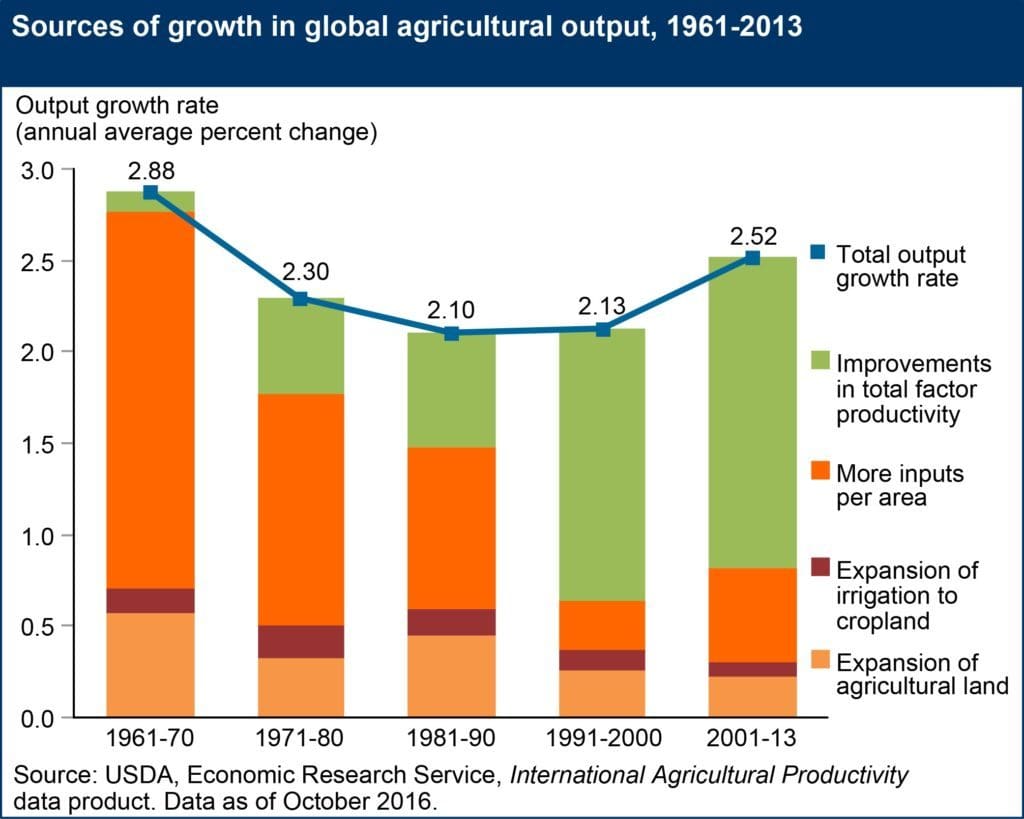A SEEMINGLY constant refrain from industry leaders and politicians is that we need to work smarter and be more productive.
In agriculture, especially Australian agriculture, several researchers have pointed to a worrying decline in productivity, especially during the first decade of this century.
However, the most recent evidence from the United States Department of Agriculture (USDA) points to a recent global uplift in agricultural productivity; an uplift also enjoyed by Australian agriculture. Globally, we are getting smarter at producing agricultural products more efficiently.
Growth in output is not coming from any marked expansion in the area of farming or large new irrigation projects or large increases in the use of farm inputs (i.e. intensification).
Rather the increased output is coming from scientists and farmers being very clever in making agricultural inputs and farming systems much more productive, extracting more output from each unit of input.
This USDA chart shows that the global increase in output since the late 1980s is mostly attributable to an increase in productivity.
The remarkable growth in productivity is allowing the world to more easily feed itself, without consuming ever increasing tracts of land for food production.
China’s agricultural production, for example, has increased more than eight-fold between 1961 and 2013, and about half of this growth is due to productivity gain.
The USDA analyses show that agricultural output has been growing fastest in lower- and middle-income countries, where food demand is also growing rapidly.
In low income countries agricultural growth is primarily driven by greater use of farm inputs.
By contrast in high income countries like Australia, where population and food demand is growing relatively slowly, growth in output is mostly through productivity gain.
In Australia, this productivity growth has allowed some land, labour and other resources to actually be withdrawn from agriculture for other uses, while still meeting domestic food demand and creating valuable exportable surpluses.
The table below lists the agricultural productivity of various countries over different periods. Since 1971 to 1990 all the listed countries have increased the growth rate of their agricultural productivity.
Annual rates of agricultural productivity growth (%)*
| 1971-1990 | 2001-13 | 2004-13 | |
| Brazil | 2.7% | 3.2% | 3.0% |
| Argentina | 0.9% | 1.0% | 1.1% |
| Canada | 0.9% | 1.7% | 1.3% |
| United States | 1.3% | 1.8% | 1.8% |
| China | 2.2% | 3.2% | 3.3% |
| India | 1.1% | 2.2% | 2.5% |
| France | 1.6% | 2.0% | 2.3% |
| Germany | 1.9% | 2.1% | 2.0% |
| Australia | 1.1% | 1.3% | 2.1% |
| Kazakhstan | -0.8% | 2.0% | 1.2% |
| Russian Federation | -0.3% | 3.0% | 2.5% |
| Ukraine | 0.3% | 2.6% | 2.5% |
*Source: USDA (2016) See http://www.ers.usda.gov/data-products/international-agricultural-productivity/summary-findings.aspx
Of particular interest to Australian grain growers, the Black Sea region countries (Russia, Ukraine and Kazakhstan) have greatly increased their agricultural productivity.
The Australian Export Grains Innovation Centre (AEGIC) recently pointed out that Ukraine and Russia now pose important competitive challenges to Australian grain exports due to the marked increases in their grain production and export prowess.
For more information see:
Kingwell, R., Elliott, P., White, P. and Carter, C. (2016) Ukraine: An emerging challenge for Australian wheat exports, Australian Export Grains Innovation Centre, April 2016. Available at: http://aegic.org.au/wp-content/uploads/2016/04/Ukraine-Supply-Chain-Full-Report.pdf
Kingwell, R., Carter, C., Elliott, P. and White, P. (2016) Russia’s wheat industry: Implications for Australia, Australian Export Grains Innovation Centre, September 2016. Available at: http://aegic.org.au/wp-content/uploads/2016/09/Russia-wheat-industry-Implications-for-Australia.pdf
In spite of Australia commendably lifting its agricultural productivity, especially in the most recent period 2004 to 2013, there are other competitor nations such as those in the Black Sea region that continue to outstrip the productivity growth of Australia.
Hence, the competitive challenges facing Australian agriculture will continue; even in a world that currently now more easily feeds itself.
Source: AEGIC



HAVE YOUR SAY